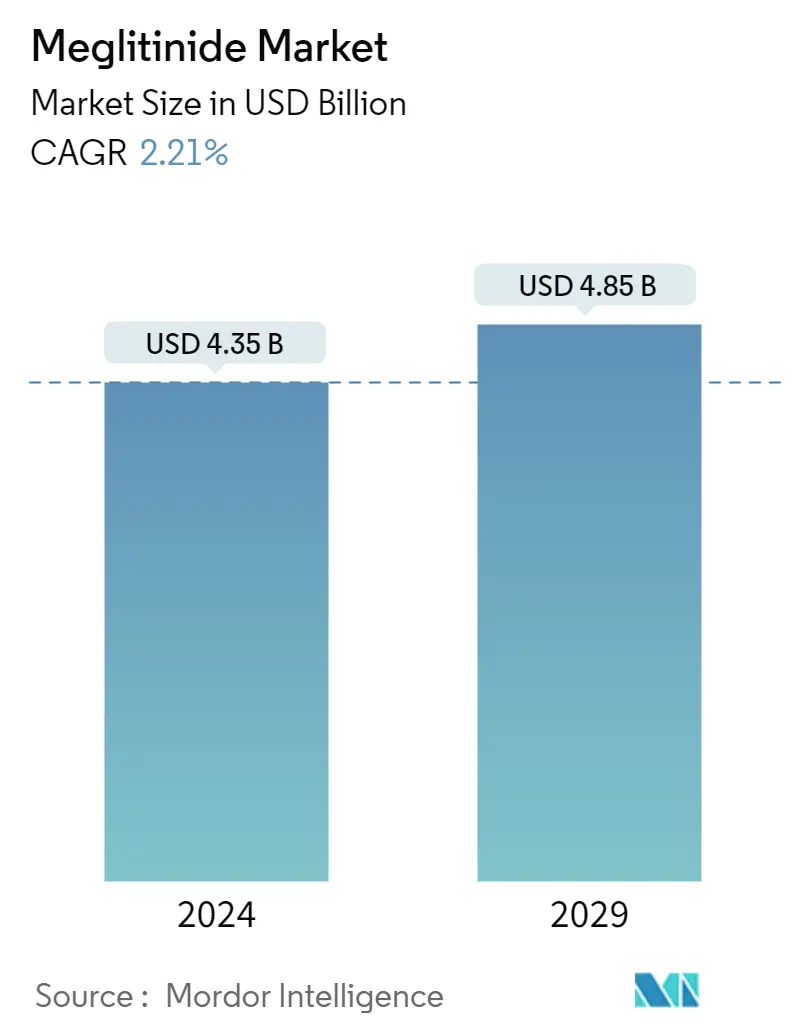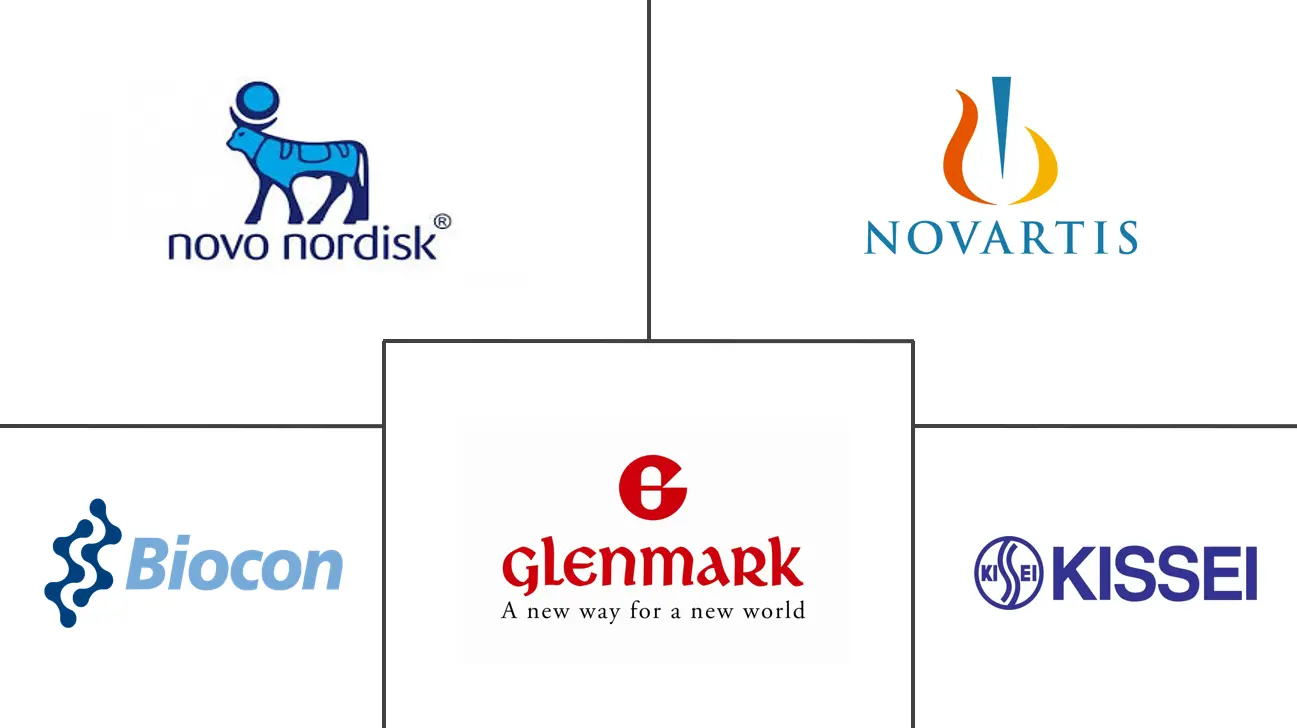| Study Period | 2019- 2029 |
| Base Year For Estimation | 2023 |
| Market Size (2024) | USD 4.35 Billion |
| Market Size (2029) | USD 4.85 Billion |
| CAGR (2024 - 2029) | 2.21 % |
| Fastest Growing Market | Middle East and Africa |
| Largest Market | Asia-Pacific |
Major Players*Disclaimer: Major Players sorted in no particular order |
Meglitinide Market Analysis
The Meglitinide Market size is estimated at USD 4.35 billion in 2024, and is expected to reach USD 4.85 billion by 2029, growing at a CAGR of 2.21% during the forecast period (2024-2029).
During the COVID-19 pandemic people with diabetes were more likely to have serious complications from COVID-19. People with diabetes have a weaker immune system, the COVID-19 complication aggravates the condition, and the immune system gets weaker very fast. Diabetes and uncontrolled hyperglycemia are risk factors for poor outcomes in patients with COVID-19 including an increased risk of severe illness or death. Thus, the COVID-19 outbreak increased the meglitinide market's growth globally.
Meglitinides are a class of non-sulfonylurea insulin secretagogues characterized by very rapid onset and shorter duration of action. They stimulate first-phase insulin release in a glucose-sensitive manner, reducing the risk of hypoglycemic events. People with type 2 diabetes have chronically high blood sugar levels and meglitinides make the body free up more insulin.
The World Health Assembly agreed on a Resolution on strengthening the prevention and control of diabetes in may 2021 which recommends action in areas including increasing access to medicines and health products for the treatment of diabetes. According to International Diabetes Federation (IDF), the adult diabetes population in 2021 is approximately 537 million, and this number is going to increase by 643 million in 2030. The rate of newly diagnosed Type 1 and Type 2 diabetes cases is seen to increase, mainly due to obesity, unhealthy diet, and physical inactivity. The rapidly increasing incidence and prevalence of diabetic patients and healthcare expenditure worldwide are indications of the increasing usage of anti-diabetic drugs. Technological advancements and innovations have increased over the period leading to several modifications either in the drugs or the formulations being developed.
Therefore, owing to the aforementioned factors the studied market is anticipated to witness growth over the analysis period.
Meglitinide Industry Segmentation
Meglitinides, or glinides, are a class of drugs used to treat type-2 diabetes. Meglitinides work by stimulating the pancreas to release insulin in response to a meal. The meglitinide market is segmented by geography (United States, Canada, and the rest of North America). The report offers the value (in USD) and volume (in units) for the above segments. Further, the report will cover a segment-wise breakdown (value and volume) for all the countries covered under the table of contents.
| North America | United States |
| Canada | |
| Rest of North America | |
| Europe | Germany |
| Spain | |
| Italy | |
| France | |
| United Kingdom | |
| Russia | |
| Rest of Europe | |
| Asia-Pacific | Japan |
| China | |
| Australia | |
| India | |
| South Korea | |
| Malaysia | |
| Indonesia | |
| Thailand | |
| Vietnam | |
| Philippines | |
| Rest of Asia-Pacific | |
| Latin America | Brazil |
| Mexico | |
| Rest of Latin America | |
| Middle East and Africa | South Africa |
| Saudi Arabia | |
| Oman | |
| Egypt | |
| Iran | |
| Rest of Middle East and Africa |
Meglitinide Market Size Summary
The meglitinide market is poised for growth over the forecast period, driven by the increasing prevalence of type 2 diabetes and the rising global demand for effective diabetes management solutions. Meglitinides, a class of non-sulfonylurea insulin secretagogues, play a crucial role in stimulating insulin release in a glucose-sensitive manner, thereby helping to manage blood sugar levels in individuals with type 2 diabetes. The market's expansion is further supported by global health initiatives, such as the World Health Assembly's resolution on diabetes prevention and control, and the WHO's Global Diabetes Compact, which aim to enhance access to diabetes treatments and care worldwide. Technological advancements in drug formulations and the growing awareness of diabetes management are also contributing to the market's positive outlook.
The Middle East and Africa region is expected to experience the highest growth rate in the meglitinide market, reflecting the alarming increase in diabetes prevalence due to lifestyle changes. The market is characterized by intense competition, with major players like Novo Nordisk, Glenmark, and Novartis actively participating. The presence of generic drug manufacturers adds to the competitive landscape. Government initiatives in regions like Saudi Arabia, aimed at improving healthcare access and affordability, are expected to further bolster market growth. Clinical trials and research continue to explore the efficacy and safety of meglitinides, reinforcing their importance in the management of type 2 diabetes.
Meglitinide Market Size - Table of Contents
1. MARKET DYNAMICS
- 1.1 Market Overview
- 1.2 Market Drivers
- 1.3 Market Restraints
-
1.4 Porter's Five Forces Analysis
- 1.4.1 Bargaining Power of Suppliers
- 1.4.2 Bargaining Power of Consumers
- 1.4.3 Threat of New Entrants
- 1.4.4 Threat of Substitute Products and Services
- 1.4.5 Intensity of Competitive Rivalry
2. MARKET SEGMENTATION
-
2.1 Geography
- 2.1.1 North America
- 2.1.1.1 United States
- 2.1.1.2 Canada
- 2.1.1.3 Rest of North America
- 2.1.1.4
- 2.1.2 Europe
- 2.1.2.1 Germany
- 2.1.2.2 Spain
- 2.1.2.3 Italy
- 2.1.2.4 France
- 2.1.2.5 United Kingdom
- 2.1.2.6 Russia
- 2.1.2.7 Rest of Europe
- 2.1.3 Asia-Pacific
- 2.1.3.1 Japan
- 2.1.3.2 China
- 2.1.3.3 Australia
- 2.1.3.4 India
- 2.1.3.5 South Korea
- 2.1.3.6 Malaysia
- 2.1.3.7 Indonesia
- 2.1.3.8 Thailand
- 2.1.3.9 Vietnam
- 2.1.3.10 Philippines
- 2.1.3.11 Rest of Asia-Pacific
- 2.1.4 Latin America
- 2.1.4.1 Brazil
- 2.1.4.2 Mexico
- 2.1.4.3 Rest of Latin America
- 2.1.5 Middle East and Africa
- 2.1.5.1 South Africa
- 2.1.5.2 Saudi Arabia
- 2.1.5.3 Oman
- 2.1.5.4 Egypt
- 2.1.5.5 Iran
- 2.1.5.6 Rest of Middle East and Africa
Meglitinide Market Research FAQs
How big is the Meglitinide Market?
The Meglitinide Market size is expected to reach USD 4.45 billion in 2025 and grow at a CAGR of 2.21% to reach USD 4.96 billion by 2030.
What is the current Meglitinide Market size?
In 2025, the Meglitinide Market size is expected to reach USD 4.45 billion.




